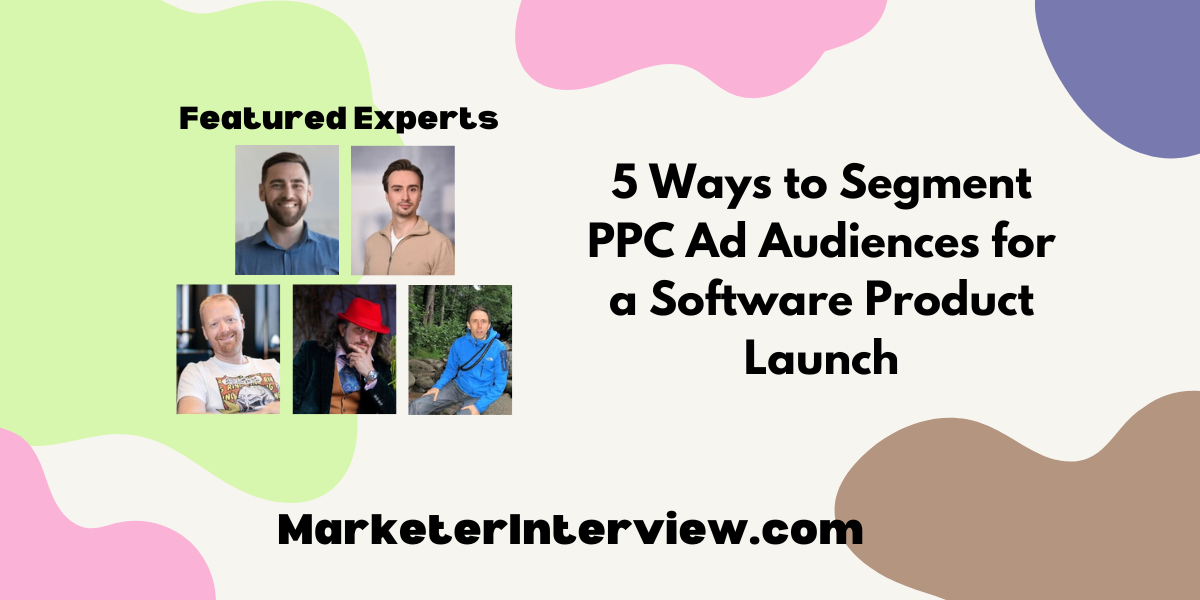5 Ways to Segment PPC Ad Audiences for a Software Product Launch
In the dynamic world of pay-per-click advertising, precise audience segmentation can make or break a software product launch. We’ve gathered five expert tips from Google Ads Specialists and Heads of Marketing, ranging from targeting users with custom segments to harnessing behavioral data for segmentation. Discover how these professionals fine-tune their strategies to captivate the right audience at the right time.
Want to get quoted in MarketerInterview.com content just like this? Apply to become a contributor today!
Contents
Target Users with Custom Segments
When launching a software product, I often use custom segments in PPC campaigns, particularly for display, video, and demand-gen efforts. This allows me to target users who visit specific types of sites or use certain apps, and those who have shown interest in related keywords.
Although it’s not ultra-precise, adding the domain and app related to a popular software in your industry can really help fine-tune your audience and improve campaign relevance and effectiveness.

Andy Hathaway, Google Ads Specialist, Clarity PPC
Segment by Behavior and Interest
This is especially crucial when launching a new software product, as targeting the wrong audience can result in wasted ad spend and low conversion rates. One specific tip for segmenting PPC ad audiences for a software product launch is to use customer segmentation based on behavior and interest.
By utilizing data from previous website visitors, email subscribers, and social media followers, you can create segmented groups of potential customers who are already interested in your software product. One way to do this is by using a custom audience feature on platforms like Facebook and Google Ads. These tools allow you to upload customer lists or use tracking pixels on your website to create specific audiences based on actions they have taken, such as visiting your product page or signing up for a demo.
Another technique is to use audience insights to understand the behavior and interests of your target market. This can help you create targeted messaging and ad content that will resonate with each segment. For example, if you are targeting small business owners, you may want to highlight the cost-effectiveness and time-saving benefits of your software in your ads.

Alex Taylor, Head of Marketing, CrownTV
Tailor Ads to the Buyer’s Journey
One highly effective technique for segmenting PPC ad audiences for a software product launch is to create distinct audience segments based on user intent and behavior. By leveraging data from your website analytics, CRM, and other customer insights, you can identify different stages of the buyer’s journey and tailor your PPC campaigns accordingly.
For instance, consider segmenting your audience into three main groups: awareness, consideration, and decision.
Awareness Stage: Target users who have shown interest in topics related to your software product but may not be familiar with your brand. Use broad keywords and interest-based targeting to reach this audience. Create ads that introduce your software and highlight its unique selling points, aiming to build brand awareness.
Consideration Stage: Focus on users who have visited your website, engaged with your content, or interacted with your social media channels. Utilize retargeting ads with more detailed information about your software’s features and benefits. Offer free trials, demos, or informative content like whitepapers and webinars to nurture their interest.
Decision Stage: Target users who have shown strong purchase intent, such as those who have signed up for a free trial, requested a demo, or added your product to their cart. Use highly specific keywords and personalized ads that emphasize customer testimonials, competitive pricing, and limited-time offers to encourage conversions.
By segmenting your audience in this manner, you can deliver highly relevant and personalized ads that resonate with users at each stage of their journey, maximizing the effectiveness of your PPC campaigns and driving more qualified leads for your software product launch.

Niclas Schlopsna, Managing Consultant and CEO, spectup
Leverage User Intent from Search Queries
When it comes to segmenting PPC ad audiences for a software product launch, one technique that has worked wonders for us is leveraging user intent signals from search queries. Imagine launching a project management tool; instead of just targeting broad keywords like “project management software,” dive into more specific queries like “best project management tool for small teams” or “software to manage remote projects.” These long-tail keywords reveal the user’s intent and can help you create highly targeted ad groups.
By doing so, you’re not just casting a wide net but fishing in a pond where the fish are already hungry for what you offer. This approach not only boosts your ad relevance but also improves your click-through rates and conversion rates. It’s like having a secret weapon that makes your PPC campaigns more efficient and effective.

Lukasz Zelezny, SEO Consultant, SEO ANT LTD
Segment High-Intent vs. Low-Intent Keywords
One of the costliest mistakes I’ve ever made as a tech marketer is not understanding the difference between high-intent and low-intent keywords. In a past CMO role, this mistake cost us over $5,000 in wasted Google Ads spent over a year.
Search intent is the most important factor to consider when segmenting keywords in competitive categories on Google Ads. It’s all about understanding what the person searching is looking to achieve. In competitive software categories, a high-intent keyword like “best accounting software” can be 5x more costly than a low-intent keyword “what is accounting software,” but the conversion rate and conversion value of high-intent keywords will be far higher. In my past experience, the ROI of high-intent keywords has been at least double that of low-intent keywords in the most competitive software-as-a-service (SaaS) categories.
When you’re looking to build Google Ads campaigns for a software launch, segment your keywords into high-intent and low-intent keywords and be sure to enable conversion tracking, so you can analyze and improve return on investment based on real conversion values.

Lari Numminen, Growth Advisor, Generate More
Want to get quoted in MarketerInterview.com content just like this? Apply to become a contributor today!






